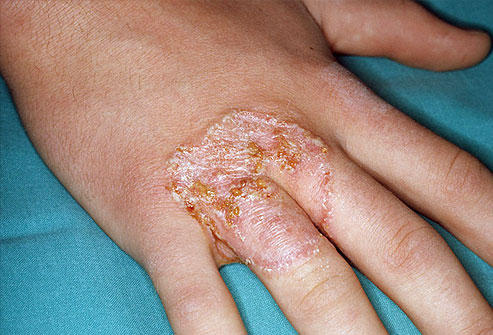Your skin’s outer layers are made of dead cells that contain the protein ‘keratin’. This makes your outer skin quite waterproof and tough, which can safeguards your body’s inner environment. Healthy skin withstands a range of microbes and can heal rapidly when injured. When your skin is not healthy and suffers an injury, numerous infections can gain entry into it, resulting in different infections such as the hand fungus. Let us find out what a hand fungus is and how it is caused.

What Is Hand Fungus?
Fungus on hands is caused by the fungus genus ‘dermatophytes.’ These fungi affect your skin and are also known as ‘ringworms’. There are various types of dermatophytes and every type affects a certain part of your body. However, only 3 particular types affect your hands. Let us explore these hand fungus in detail.
- Tinea manuum: Tinea manuum affects your palms and hands. Signs of the tinea manuum fungus on hands include: crackling or scaly skin, inflammation, burning and itching of the affected region.
- Ringworm on Nail (tinea unguium): Tina unguium affects your nails, most commonly your toe nails. It also affects your fingernails occasionally as well. This nail ringworm is referred to as ‘onychomycosis’ in medical terms. Its symptoms include discolored (black, yellow or green) and thickened nails, inflammation and scaly skin around your infected nail, and completely breaking off of the nails.
- Tinea nigera: It results in superficial phaeohyphomycosis. This infection isn’t activated by any dermatophyte, but is caused by another kind of fungus known as hortaea werneckii. Signs of tinea nigera include unpainful patches on your hand and black or dark brown colored patches on your palms or feet’s soles.
How to Deal With Hand Fungus
Hand fungus can be dealt with home remedies or different medications. Treatments are usually designed for clearing the infection. However, in certain cases, this condition tends to recur. Home remedies help you save money and are quite helpful as well. However, if they fail, you need to resort to proper medications according to the type of your hand fungus.
Home Remedies for Hand Fungus
Many people suffering from fungus on hands have benefitted from these homemade antidotes.
- Tea tree oil: This oil has antifungal and antimicrobial properties, making it effective in curing hand fungus. Pour 5 to 6 drops of the oil in a tub and soak both your hands in it for relieving discomfort caused by hand fungus.
- Hydrogen peroxide: Soaking the infected hand in hydrogen peroxide can kill the hand fungus completely. However, it may dry out your hand, so use a good moisturizer after applying this remedy.
- Vinegar: Soaking the infected hand in plain white or apple cider vinegar can control the spread of hand fungus.
- B-complex vitamins: B-complex vitamins are chief components of a healthy skin. Taking these in the supplement form or eating foods rich in these vitamins helps in preventing the onset of hand fungus.
- Cat’s claw: Consuming about 20mg cat’s claw about thrice a day can help in curing hand fungus, but it’s best to consult your doctor prior to using it as it can interfere with other medicines.
- Probiotics like lactobacillus help in balancing the skin flora, hence preventing fungal infections.
- Fish oil contains anti-inflammatory agents that reduce chronic inflammation caused by a hand fungus. Use it in supplement form or incorporate fish in your daily diet.
- Grapefruit seed extract: This is a great antidote for fungus on hands. Grapefruit has immunity building and antifungal properties that help it in managing the hand fungus.
- Sulfur if often used for treating hand fungus in homeopathic medications. Most of the anti-fungal creams contain this agent as well.
- Consuming green tea and soaking your hands in good quality hand wash can also help you get relief from hand fungus. To manage the hand fungus, always dry out your hand after practicing any home remedy
- Never share your manicure sets or nail clippers with anyone and wear gloves for preventing the fungus from spreading elsewhere.
To ensure any of these remedies does not backfire, you must consult with your dermatologist before implementing them.
Medication for Hand Fungus
Medical treatment of hand fungus includes using antifungal creams. Many antifungal creams and lotions are easily available. The commonly used ones include miconazole, clotrimazole, tioconazole and econazole. Clotrimazole cream has the best effect on hand fungus. It is known to be the best and most effective cream for treating different fungi of the hand. It is mainly used for treating tineamanuum, but is also used for curing vaginal yeast, jock itch, ringworm and oral thrush infections along with athlete’s foot.
Antifungal creams are often available over the counter. However, it is better if you have a doctor’s prescription as these creams may have sideeffects like hives, burning, and swelling, redness, rash, blistering, itching and burning.